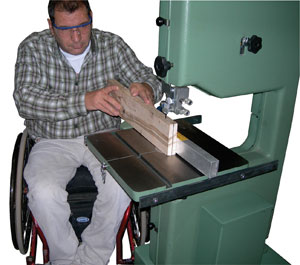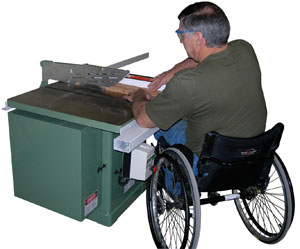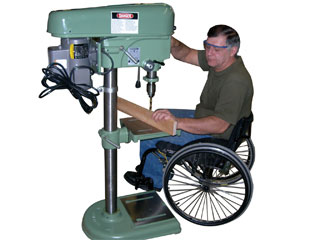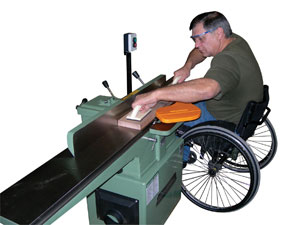
At the end of a long day in the shop, I sometimes grumble about feeling the ache in my legs. Woodworking on two feet is really the only way I know how to do things. Not long ago, however, I learned that General offers a line of woodworking machinery customized specifically for woodworkers in wheelchairs. It gave me pause to consider those of you who may be in this situation, as well as good reason to get on the phone with Norman Frampton, General’s Director of Marketing and Communications, to learn more about this unique tool family.
The Access by General line of machinery was conceived just two years ago, nudged on in part by woodworkers who wanted better solutions for machinery to suit accessibility issues. “After a year or so of hearing these kinds of questions come up at trade shows and other venues, we asked ourselves why no one is making machinery for people in wheelchairs,” Frampton recalls. “It occurred to us that maybe we should be one of the first companies to do it.”
Initially, General didn’t conduct a formal market study to confirm the viability of a wheelchair accessible line of machinery. But the decision seemed logical enough on its own, given the bubble of aging Baby Boomers in our population. “Some of these folks are now beginning to face mobility issues, but they can still afford to invest in their woodworking hobbies and have had active shops their whole lives. They want to keep woodworking despite the wheelchair,” Norman says.
The company launched the Access by General line with five machines: a 10″ tilting arbor cabinet saw, a 16″ x 42″ lathe, 15″ drill press, 8″ jointerand a 15″ wood-cutting band saw. “Our goal was to cover the basic machines for furniture-making. The only machine we don’t offer at this time is a stationary planer, but planers are already at an acceptable height for most wheelchair users,” Frampton says.
General didn’t start from scratch to build these tools. The Access line consists of pre-existing models: four are made in the company’s Drummondville, Montreal, manufacturing plant and one is built overseas within its subsidiary General International line.
In addition to modifying the tools to change conventional work surface and tabletop heights, two other big issues to resolve were safety and improved legroom. Power switches are relocated to make them operable from a seated position, and bases or columns were redesigned to accommodate a 22″ to 24″ seat height. Frampton says the tool that required the most initial customization was the table saw. “We had to go back to the drawing board after testing our prototype saw with several end users. The saw required that we shift the tabletop forward on the cabinet and modify one of the castings to suit that change.” But the process has been worth it; Frampton says the table saw continues to be the best-selling Access by General offering.
Frampton believes the company was in a uniquely advantageous position to make these sorts of model changes, given that it owns both a castings foundry and manufacturing facility right down the road from one another. The Drummondville operation currently manufactures some 20 different conventional machine models, including lathes, table saws, band saws, jointers, planers and drill presses. “We are able to make quick and almost instantaneous modifications to our machinery because we own our own plants. It gives us the ability to manufacture what we want when we want…We knew the development phase of the Access by General line would be a trial-and-error process, particularly with testing. It’s much easier to do this in your own factory.”
In the past two years, Frampton says that end user response to Access by General tools has been overwhelmingly positive, even if sales have been more modest than the company initially hoped. About two-thirds of the machines that leave the plant are headed to Canadian shops. Still, General envisions that the interest in these tools will grow over time – particularly with better advertising here in the States and a network of U.S. dealerships that are now supported with the company’s new Tennessee-based distribution center.
At the present time, Frampton says General doesn’t plan to branch out beyond the five types of wheelchair-accessible machines it currently offers, and it also doesn’t anticipate developing machines to help people with other kinds of disabilities such as visual impairment. However, they may eventually offer several different models of each tool type within the Access line in a broader range of pricing.
In that regard, I was pleased to learn that Access by General tools are priced the same as their conventional-model counterparts. You don’t pay more for a modified machine.
I was curious to find out whether General is willing to consider special requests for machine modifications that fall outside of what comes standard on Access tools. Norman says the company “wouldn’t say no without taking a serious look at it. It would depend on the type of modification required and how expensive it would be to both the company and end user to create a ‘one-off’ tool. We’d have to treat it on a case by case basis.”
Still, even with a five-machine line-up, General is certainly helping more woodworkers stay active in their shops longer and with fewer restrictions imposed by conventional woodworking tools. Your local General dealership may even be able to help you get your new lathe or band saw unloaded and into the shop. “As much as possible, our dealer network will try to accommodate our customer needs as best they can,” Frampton says. “That’s part of the reason why we choose to work with dealers. They are able to provide that bit of extra service that might make all the difference in this situation.”









